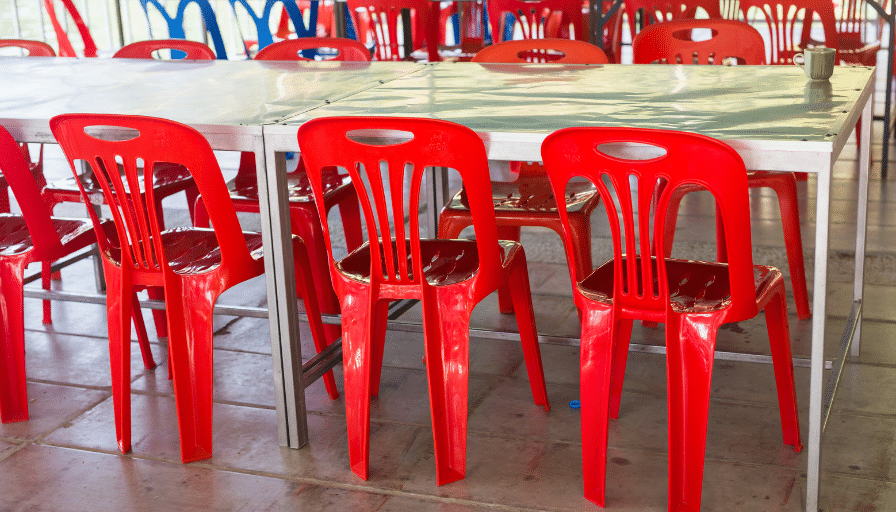How to Clean Plastic Dining Chairs?
Plastic dining chairs are a popular choice for many households due to their affordability, durability, and ease of maintenance. However, over time, these chairs can accumulate dirt, stains, and grime, making them appear worn and unattractive. To maintain the cleanliness and longevity of your plastic dining chairs, it is essential to clean them regularly using proper techniques and cleaning products.
In this article, we will provide you with detailed instructions on how to effectively clean your plastic dining chairs. As a furniture cleaning specialist, I will share my expertise and knowledge in the field of furniture cleaning to ensure that you achieve the best results. We will discuss the necessary cleaning supplies, the steps to prepare the chairs for cleaning, and the techniques to remove stains and grime effectively.
Additionally, we will cover the cleaning of chair legs and frames, as well as provide tips on drying and maintenance.
By following these step-by-step instructions and utilizing the recommended cleaning products, you can restore the cleanliness and appearance of your plastic dining chairs, allowing you to enjoy them for years to come.
Gather Necessary Cleaning Supplies
To begin the process of cleaning plastic dining chairs, it is essential to gather all the necessary cleaning supplies. Cleaning solutions specifically designed for plastic surfaces are highly recommended for this task. These solutions are typically mild and gentle, ensuring that they do not cause any damage to the plastic material. It is important to avoid using harsh chemicals or abrasive cleaners, as they can potentially scratch or discolor the chairs.
When it comes to scrubbing techniques, it is advisable to use a soft-bristle brush or a sponge. These tools are gentle enough to avoid scratching the plastic while still being effective in removing dirt and stains.
Begin by wetting the brush or sponge with the cleaning solution and then gently scrub the surface of the chairs in a circular motion. Pay close attention to any areas with stubborn stains or grime, applying a bit more pressure if necessary.
After scrubbing, rinse the chairs thoroughly with clean water to remove any remaining cleaning solution. It is important to ensure that no residue is left behind, as this can attract more dirt and make the chairs appear dull.
Finally, dry the chairs completely using a clean cloth or allow them to air dry naturally.
By following these cleaning techniques and using suitable cleaning solutions, plastic dining chairs can be effectively cleaned, maintaining their appearance and extending their lifespan.
Preparing the Chairs for Cleaning
Before starting the cleaning process, it is essential to ensure that the chairs are free from any loose debris or food particles. This can be achieved by gently brushing or vacuuming the chairs to remove any surface dirt or crumbs. It is important to be thorough in this step to prevent the spread of dirt or contaminants during the cleaning process.
Once the chairs are free from loose debris, the next step is to choose the right cleaning solution. When it comes to cleaning plastic dining chairs, it is recommended to use a mild detergent or dish soap mixed with warm water. This solution is effective in removing grease, stains, and dirt without damaging the plastic material. It is important to avoid using harsh chemicals or abrasive cleaners as they can cause discoloration or scratches on the chairs.
To prepare the cleaning solution, mix a small amount of mild detergent or dish soap with warm water in a bucket or basin. Stir the solution gently to create a soapy mixture. It is important to avoid using excessive amounts of detergent as it can leave behind a residue on the chairs.
Before cleaning plastic dining chairs, it is crucial to remove any loose debris or food particles. Additionally, choosing the right cleaning solution, such as a mild detergent or dish soap mixed with warm water, is essential for effective and safe cleaning. By following these pre-cleaning steps and using the appropriate cleaning solution, the plastic dining chairs can be thoroughly cleaned and maintained in good condition.
Removing Stains and Grime
Stains and grime can be effectively eliminated from the surface of the chairs by using a mild detergent or dish soap mixed with warm water.
To clean plastic dining chairs, it is important to use the right cleaning techniques and homemade cleaning solutions.
First, prepare a cleaning solution by mixing a few drops of mild detergent or dish soap with warm water in a bucket or basin. Gently stir the solution until it becomes soapy.
Then, dampen a soft cloth or sponge with the soapy water and begin cleaning the surface of the plastic chairs. For stubborn stains or grime, it may be necessary to gently scrub the affected areas with a soft-bristled brush.
After cleaning, rinse the chairs thoroughly with clean water to remove any soap residue. It is important to avoid using abrasive cleaners or harsh chemicals, as they can damage the plastic surface. Additionally, never use bleach or ammonia-based cleaners, as they can discolor or weaken the plastic.
Once the chairs are clean, dry them with a clean, lint-free cloth to prevent water spots or streaks. It is recommended to clean the chairs regularly to maintain their appearance and prolong their lifespan.
By following these simple cleaning techniques and using homemade cleaning solutions, you can effectively remove stains and grime from your plastic dining chairs.
Deep Cleaning the Chair Surfaces
One effective method for thoroughly sanitizing the chair surfaces involves employing a deep cleaning technique. To start, it is crucial to choose the appropriate cleaning solution for plastic dining chairs.
Mild dish soap mixed with warm water can be a safe and effective option. Alternatively, a mixture of vinegar and water can also be used, as vinegar has natural disinfectant properties. It is important to avoid using abrasive or harsh chemicals that can damage the plastic surface.
To begin the deep cleaning process, first, remove any loose dirt or debris by wiping the chair surfaces with a soft cloth or sponge. Then, dip a clean cloth or sponge into the chosen cleaning solution and gently scrub the chair surfaces in a circular motion, paying extra attention to stained or heavily soiled areas. Rinse the chair thoroughly with clean water to remove any residue from the cleaning solution.
To prevent future stains, it is advisable to apply a protective coating to the plastic chair surfaces. This can be done by using a plastic protectant spray or by applying a layer of car wax onto the chair. These protective coatings act as a barrier against spills and stains, making it easier to clean the chair in the future.
By following these steps and using the appropriate cleaning solution, one can effectively deep clean plastic dining chairs and prevent future stains.
Cleaning Chair Legs and Frames
The next step in the cleaning process involves attending to the legs and frames of the chairs. To ensure a thorough cleaning, it is important to clean all aspects of the chair, including the chair cushions and hardware.
To clean the chair cushions, start by removing them from the chair if possible. If the cushions are removable, follow the manufacturer’s instructions for cleaning. Typically, you can spot clean the cushions using a mild detergent and warm water. Gently scrub any stains or dirt using a soft brush or sponge. Rinse the cushions thoroughly and allow them to air dry before placing them back on the chair.
When it comes to the chair hardware, such as screws, bolts, and hinges, they can be cleaned using a mild detergent or vinegar solution. Apply the cleaning solution to a soft cloth and gently wipe down the hardware. For stubborn stains or grime, use a soft brush to scrub the affected areas. After cleaning, rinse the hardware with clean water and dry thoroughly.
In addition to cleaning, you may also want to consider polishing the chair hardware to restore its shine and prevent tarnishing. Use a suitable metal polish or a homemade solution of vinegar and baking soda to polish the hardware. Apply the polish using a soft cloth and buff until the desired shine is achieved.
By following these cleaning and polishing techniques, you can ensure that your plastic dining chairs remain clean, comfortable, and visually appealing.
Drying and Maintenance Tips
To ensure the longevity and preservation of the chair’s condition, proper drying techniques and regular maintenance are essential. After cleaning the plastic dining chairs, it is important to allow them to dry completely before using them again. This will prevent any moisture from being trapped, which can lead to the growth of mold or mildew.
To expedite the drying process, wipe down the chairs with a dry cloth or towel to remove any excess water. Additionally, placing the chairs in a well-ventilated area or using a fan can help speed up the drying time.
Regular maintenance is also crucial in preventing future damage to the plastic dining chairs. It is recommended to clean the chairs at least once a month to remove any accumulated dirt or grime. To clean the chairs, use a mild detergent mixed with warm water and gently scrub the surfaces with a soft sponge or cloth. Avoid using abrasive cleaners or scrub brushes, as they can scratch or damage the plastic material. After cleaning, rinse the chairs thoroughly with clean water to remove any residue from the detergent.
Proper drying techniques and regular maintenance are vital for maintaining the condition of plastic dining chairs. By following these guidelines, you can ensure that your chairs remain clean, functional, and aesthetically pleasing for years to come.
Frequently Asked Questions
How often should I clean my plastic dining chairs?
Plastic dining chairs should be cleaned regularly to maintain hygiene and appearance. The frequency of cleaning depends on usage and personal preference. Use mild soap, water, and a soft cloth to remove dirt and stains.
Can I use bleach to clean my plastic dining chairs?
Bleach alternatives are recommended for cleaning plastic dining chairs as bleach may cause discoloration or damage. Instead, use mild soapy water, vinegar, or baking soda solutions. Avoid abrasive cleaners and scrub gently with a soft cloth to maintain the chairs’ appearance and longevity.
How do I remove stubborn stains from my plastic dining chairs?
To remove stubborn stains from plastic dining chairs, it is important to choose the right cleaning products and techniques. Use a mild detergent or baking soda paste, scrub gently with a soft brush, and rinse thoroughly. Apply a protective wax or spray to prevent future staining.
Can I use a pressure washer to clean my plastic dining chairs?
Using a pressure washer to clean plastic dining chairs is not recommended due to the potential for damage and safety hazards. It is advisable to use alternative cleaning methods, such as mild soap and water, or specialized plastic cleaner, to ensure the longevity and safety of the chairs.
How can I prevent my plastic dining chairs from becoming discolored over time?
To prevent discoloration of plastic dining chairs over time, it is important to use proper cleaning techniques. This includes using mild cleaning agents, avoiding abrasive materials, and regularly wiping down the chairs to remove any dirt or stains.
Conclusion
In conclusion, cleaning plastic dining chairs requires the use of specific cleaning supplies and techniques.
As a furniture cleaning specialist, it is important to provide detailed instructions and precautions to ensure effective cleaning. By using clear and simple language, readers can easily follow the step-by-step explanations.
Maintaining a professional tone and presenting information in an organized manner adds credibility to the instructions. Addressing potential concerns and offering alternative solutions demonstrates expertise and ensures a successful cleaning process.







